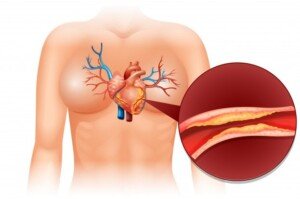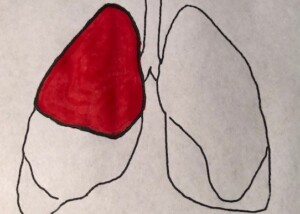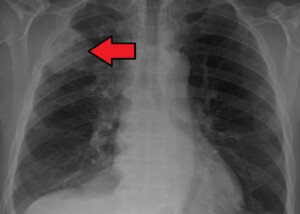Both lung cancer and heart disease can cause chest pain though it’s far more common in heart disease.
What are the differences in how the chest pain feels when it’s being caused by lung cancer vs. heart disease?
The term “heart disease” is an umbrella term that includes coronary artery disease (clogged or blocked arteries) and chronic heart failure (weakly pumping heart).
You’ve been having unexplained chest pain lately and are worried.
You’ve been smoking for many years. Or maybe you’ve never smoked. Nevertheless, the new symptom has you quite worried.
Is this more likely to be from lung cancer or from some form of heart disease?
“Lung cancer typically does not cause chest pain — as it is buried in the lung which does not have pain receptors,” says Alex Little, MD, a thoracic surgeon with a special interest in esophageal and lung cancer.
But there is a circumstance under which a malignant tumor affecting the lung can result in chest pain.
Dr. Little explains, “A lung cancer that is peripheral (at a lung edge) and invades the chest wall (most frequently at the lung apex, called a Pancoast tumor) — it causes a steady, unrelenting pain localized at that site related to irritation of nerves in the chest wall. It is not made better by rest.”
Coronary Artery Blockage
“The classic chest pain associated with heart disease is usually described as a severe squeezing or pressure sensation that is generally made worse with activity,” says Christopher J. Hanifin, PA-C, who was previously a physician assistant in open heart surgery with Cardiothoracic Surgery of South Bend in South Bend, IN.

Freepik.com brgfx
“If the bottom surface of the heart is affected, the pain may be difficult to distinguish from a stomach problem like heartburn,” continues Hanifin.
“The pain associated with coronary artery disease is usually not described as sharp.”
Dr. Little elaborates: “The imbalance between oxygen need and supply results in ischemic muscle (it has a relative deficiency of blood and therefore oxygen) — and the person has chest pain, called angina.
“The pain is usually in the chest, frequently spreading to the left shoulder and even down the left arm.
“It is steady but improves with rest as the heart slows, diminishing its oxygen needs.”
Considerations when Comparing Chest Pain from Lung Cancer with Heart Disease
“Cancer that affects the chest wall can cause a sharp pain that gets worse with deep breathing,” says Hanifin.
This can fool the patient into thinking he or she has a strained muscle.
But this symptom, however, almost always has a cause other than lung cancer.
As for angina, there’s a type called “unstable” in which the patient experiences spontaneous chest pain: in the absence of physical or emotional exertion. It may happen even during sleep, rousing them.
While one long-time smoker may immediately wonder about lung cancer upon having chest pain, another chronic smoker may be tuned into heart disease.
After all, smoking causes FAR MORE heart disease than lung cancer.
Anyone who smokes should fear both diseases, but it’s life-threatening heart disease (blocked arteries and weak pumping) that the smoker is much more likely to develop.
In fact, heart disease affects far more nonsmokers than ANY cancer.
Chest Pain and Going to the ER
Chest pain has many causes including some benign ones (e.g., strained cartilage in the ribcage, acid reflux, esophageal spasm), not to mention serious including a blood clot in a lung and lymphoma.
This is why any troubling chest pain requires a visit to the ER where a blood test will rule out (or in) a very recent heart attack.
Further testing can reveal the presence of a life-threatening pulmonary embolism: the blood clot.
An X-ray will reveal possible causes such as lung cancer, pneumonia, fluid in a lung from heart failure, and a bulge in the heart’s great vessel, the aorta.
Additional factors to consider is if the patient has other symptoms such as shortness of breath, unexplained fatigue or weight loss, nausea, profuse sweating, a new and persistent cough, a cough that produces blood-tinged sputum, and if the chest pain occurs only when the patient is in certain body positions.
One more point to note:
A person need not be a smoker to develop lung cancer or severe heart disease.
So if you have any concerning symptoms, do not hesitate to get a medical evaluation.
 Alex Little, MD, trained in general and thoracic surgery at the Johns Hopkins University School of Medicine; has been active in national thoracic surgical societies as a speaker and participant, and served as president of the American College of Chest Physicians. He’s the author of “Cracking Chests: How Thoracic Surgery Got from Rocks to Sticks,” available on Amazon.
Alex Little, MD, trained in general and thoracic surgery at the Johns Hopkins University School of Medicine; has been active in national thoracic surgical societies as a speaker and participant, and served as president of the American College of Chest Physicians. He’s the author of “Cracking Chests: How Thoracic Surgery Got from Rocks to Sticks,” available on Amazon.
 Christopher J. Hanifin, PA-C, is currently Department Chair and Assistant Professor, Department of Physician Assistant, Seton Hall University,
Christopher J. Hanifin, PA-C, is currently Department Chair and Assistant Professor, Department of Physician Assistant, Seton Hall University,
 Lorra Garrick has been covering medical, fitness and cybersecurity topics for many years, having written thousands of articles for print magazines and websites, including as a ghostwriter. She’s also a former ACE-certified personal trainer.
Lorra Garrick has been covering medical, fitness and cybersecurity topics for many years, having written thousands of articles for print magazines and websites, including as a ghostwriter. She’s also a former ACE-certified personal trainer.
.










































